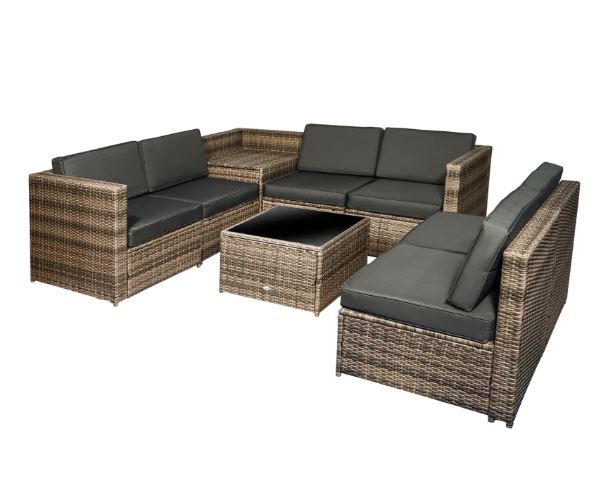Welcome, DIY enthusiasts! Are you looking at that old rattan chair in your conservatory and thinking it's time to refresh?
Painting rattan can be easy and rewarding with the right approach. If you want to learn how to paint rattan garden furniture, let's review all the steps — from choosing the best paint to preparing and applying it. Your furniture will look great and last through the seasons, transforming your conservatory into a vibrant and inviting space.
Can You Paint Rattan Furniture?
Absolutely! Rattan's naturally porous surface makes it ideal for a fresh coat of paint, allowing it to absorb and hold paint well. This quality also ensures that the paint penetrates the surface effectively, producing a finish that's as long-lasting as it is visually pleasing. This can be a fantastic way to refresh your rattan sofa sets or sun loungers or update your garden furniture to match any decor style better.
Advantages of Painting Rattan
Painting rattan has some key benefits, including that:
- Improves the furniture's durability: A protective layer of paint can help shield the rattan from wear and tear.
- Provides a fresh, new look: Painting allows you to refresh the appearance of your furniture, making it look updated and well-maintained.
- Allows customisation to fit any decor: With a range of colours available, you can quickly adapt the furniture to match your interior or outdoor style.
- Concealing imperfections: Paint can hide minor blemishes, scratches, or fading, giving the rattan a smooth and polished finish.
- Improves resistance to moisture and UV rays: Painted rattan is better protected from sun exposure and moisture, helping it withstand outdoor conditions longer.
Required Materials for Painting Rattan
Gather all the necessary materials before embarking on your painting journey. This preparation will make the process smoother and more enjoyable and save you precious time.
- Rattan furniture: Select your rattan garden furniture or any rattan items you wish to transform
- Sandpaper: This is essential for prepping the surface before painting.
- Primer: Primer is necessary to ensure proper paint adhesion to the rattan surface.
- Acrylic or spray paint: Choose colours that resonate with your style and complement your space.
- Paintbrushes or spray paint can be used, depending on your preferred method of paint application.
- Drop cloth or plastic sheeting: Lay these down to protect your workspace from any spills or paint splatter.
- Face mask and ventilation: Wear a face mask and ensure proper ventilation to prevent inhaling harmful fumes.
Professional Tip: When painting rattan or poly rattan furniture, consider using a sample patch to test how your primer and paint adhere to the rattan. This will help ensure the colours and finish meet your expectations before you commit to the entire project.
How to Paint Rattan Furniture: A Step-by-Step Guide
Step 1: Prepare your workspace.
Find a well-ventilated area for painting. Lay down a drop cloth or plastic sheeting to protect the floor and surrounding area.
Step 2: Clean the furniture.
Use mild detergent and warm water to clean each piece of furniture. A soft brush or cloth works best. Allow the furniture to dry completely.
Step 3: Sand the surface.
Use fine-grit sandpaper for a smooth finish. Be sure to sand lightly to improve the primer's adhesion.
Step 4: Apply primer.
Choose a suitable primer for rattan and apply an even coat, covering all areas of the furniture.
Step 5: Paint the furniture.
Select either acrylic paint or rattan furniture spray paint. Apply thin, even coats for the best finish. Allow each coat to dry before starting the following application.
Step 6: Seal the paint.
Use a clear acrylic sealer for protection and aim for even coverage for long-lasting results.
Step 7: Let the furniture cure.
Allow the furniture to cure for at least 24 hours before returning it to its proper location and using it.
Professional Tip: Avoid heavy brush strokes when painting rattan to prevent excess paint buildup in the weave. Instead, use light, even coats to ensure the paint covers the material evenly without clogging the rattan's natural texture.
The Best Paint for Rattan Furniture
Choosing the right type of paint is crucial if you want to get the best results. Here are some options:
- Acrylic paint: Versatile and available in many colours, perfect for hand-painting.
- Spray paint: Offers easy application and a smooth finish.
- Chalk paint: Known for its matte finish and vintage look.
- Outdoor paint: Ideal if the furniture is exposed to the elements.
Professional Tip: When selecting paint, consider the specific environment where you'll place your rattan furniture. For furniture that will stay outdoors, prioritise high-quality outdoor paint for weather resistance. Meanwhile, opt for acrylic or chalk paint for pieces you'll keep indoors.
For more about selecting rattan furniture, refer to our guide to buying rattan furniture, which covers quality and style tips to complement your paint choice.
Can You Spray Paint Rattan Furniture?
Spray painting is another way to revamp your rattan furniture and update its colour. It's particularly effective for applying an even coat to the intricate weaves of rattan.
Steps for Spray Painting Rattan Furniture
- Follow the same preparation steps as above.
- For the smoothest finish, use even sweeping motions, holding the spray can 20-25 cm (8-10 inches) from the surface.
- Allow the paint to dry completely before applying the next coat. Applying multiple light coats instead of one heavy coat will ensure even coverage without oversaturating the weave. This is especially useful for detailed pieces like rattan bistro sets with intricate rattan designs.
Professional Tip: For the best finish, spray paint rattan furniture outdoors or in a well-ventilated area to avoid inhaling fumes.
How to Revamp Your Conservatory Furniture
Beyond painting, additional ways exist to revamp your conservatory furniture for a complete makeover. Here are five ways to refresh your pieces.
1. Reupholster Your Cushions
Choose stylish, durable fabrics for your cushions. Reupholstering freshens up the look and improves comfort. Select high-quality fabrics that complement your existing colours and add visual interest with bold patterns or textures. Opt for high-density foam for cushions to provide long-lasting comfort.
2. Rearrange the Furniture
Try out new layouts to transform the room's atmosphere. A rearranged setup can create focal points, maximise space, and improve flow. Consider how you want to use the room and arrange your furniture for a practical yet visually appealing look.
3. Add Indoor Plants
Add some life to your space with indoor plants! Greenery brings a natural touch and instantly brightens the room. Choose low-maintenance plants like ferns or snake plants, which thrive in indirect light and are perfect for conservatories. Coordinate decorative pots with your colour scheme and vary plant heights around the space to add depth and dimension.
4. Add Decorative Accessories
Layer textures with throw pillows, rugs, and blankets to create a cosy, welcoming atmosphere. Wall art and framed prints that reflect your style add personality and character to the room. Use rugs as a visual anchor for seating areas — they add warmth while tying the decor together beautifully.
5. Add Lighting
Improve your space's ambience with soft, warm lighting for a cosy feel. Combine overhead lighting with floor lamps or sconces to adjust the light depending on the day. Use mirrors or light-coloured accents to amplify natural light, giving your conservatory a bright, airy feel throughout the day.
Frequently Asked Questions
What kind of paint do you use on rattan furniture?
Acrylic or outdoor spray paint is ideal for rattan furniture as it adheres well to the surface, offers a smooth finish, and is durable for indoor or outdoor use.
Do you need to sand rattan before painting?
Yes, lightly sanding rattan with fine-grit sandpaper is recommended to create a smooth surface for paint adhesion and remove rough edges.
How can I change the colour of my rattan?
After sanding and priming the surface, you can change the colour of the rattan by applying an even coat of spray paint or acrylic paint in your desired shade.
Is it better to spray paint or brush paint wicker?
Spray painting is generally better for wicker as it evenly coats intricate weaves without leaving brush marks, offering a cleaner, more professional finish.

